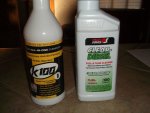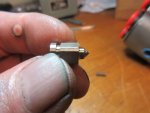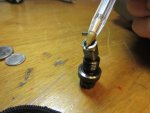carhug12
New member
- 19
- 0
- 1
- Location
- Springfield Missouri
Long time lurker, it's because of y'all I bought an M35A2. I have previously searched the forum and couldn't find an answer, so I am posting. This could entirely be from not having enough experience to search properly, if so, my apologies in advance.
Below is a youtube link showing the problem.
I was doing preventative maint.
1) Start engine, started up fine, no issues
2) Run a can of SeaFoam intake through.( Squirts into air intake)
3) 9/10 of the way through the can realize can states, NOT FOR DIESEL ENGINES!!!!
4) Oh shit moment happens, finish the can off anyways.
5) Turn off engine as per instructions and wait 15min.
6) Attempted to turn on. Wouldn't start, but really healithly wants to turn over it just wont.
Break for 2 weeks.
Ordered oil and fuel filters. Decided to change fuel filters with the WIX as suggested by Duce and Guns.
1) Changed fuel filters, primary, secondary and final along with gaskets.
2) Bled fuel lines until fuel came out.
3) Crank over and nothing happens.
4) Using starter fluid the engine will turn over and run, but will die upon 1second of letting off starter fluid. It also makes the engine sound like it's going to explode and kill everyone.
5) Logic states fuel isn't going to the engine because it's apparent that it WANTS to turn start, turns over fine, it just one.
Testing, removed the 12pt screw on the hydraulic 6 cylinder pump. Upon kicking the power on (But not cranking it) fuel will squirt from that.
Cracked the fuel lines 11/16 on the hydrolic head, and right up at the top. No fuel will come out. Either with power on, or while trying to crank it.
Let me know if anyone wants any more videos and i'll get them up ASAP! You can assume that I am completely incompetent and barely know what a wrench is. Any help would be appreciated!
Unrelated, what is the part of the fuel injector pump that the throttle/accelerator linkage attaches too called? It's wired shut, and can be seen in my video, I'm about to take it apart next in troubleshooting despite it being safety wired shut. My assumption is that the linkage turns, but there is an internal govner or something that is gummed up and keeping the fuel from getting where it needs to go. Though....i'm unsure as the fuel makes it to that 12 point nut on the end of the hydraulic head does have fuel.
Below is a youtube link showing the problem.
I was doing preventative maint.
1) Start engine, started up fine, no issues
2) Run a can of SeaFoam intake through.( Squirts into air intake)
3) 9/10 of the way through the can realize can states, NOT FOR DIESEL ENGINES!!!!
4) Oh shit moment happens, finish the can off anyways.
5) Turn off engine as per instructions and wait 15min.
6) Attempted to turn on. Wouldn't start, but really healithly wants to turn over it just wont.
Break for 2 weeks.
Ordered oil and fuel filters. Decided to change fuel filters with the WIX as suggested by Duce and Guns.
1) Changed fuel filters, primary, secondary and final along with gaskets.
2) Bled fuel lines until fuel came out.
3) Crank over and nothing happens.
4) Using starter fluid the engine will turn over and run, but will die upon 1second of letting off starter fluid. It also makes the engine sound like it's going to explode and kill everyone.
5) Logic states fuel isn't going to the engine because it's apparent that it WANTS to turn start, turns over fine, it just one.
Testing, removed the 12pt screw on the hydraulic 6 cylinder pump. Upon kicking the power on (But not cranking it) fuel will squirt from that.
Cracked the fuel lines 11/16 on the hydrolic head, and right up at the top. No fuel will come out. Either with power on, or while trying to crank it.
Let me know if anyone wants any more videos and i'll get them up ASAP! You can assume that I am completely incompetent and barely know what a wrench is. Any help would be appreciated!
Unrelated, what is the part of the fuel injector pump that the throttle/accelerator linkage attaches too called? It's wired shut, and can be seen in my video, I'm about to take it apart next in troubleshooting despite it being safety wired shut. My assumption is that the linkage turns, but there is an internal govner or something that is gummed up and keeping the fuel from getting where it needs to go. Though....i'm unsure as the fuel makes it to that 12 point nut on the end of the hydraulic head does have fuel.






